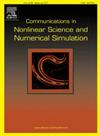模拟圆旋转的间隔映射
IF 3.4
2区 数学
Q1 MATHEMATICS, APPLIED
Communications in Nonlinear Science and Numerical Simulation
Pub Date : 2025-05-27
DOI:10.1016/j.cnsns.2025.108963
引用次数: 0
摘要
我们研究了实线映射在不变区间上的行为接近于圆上的有理旋转的动力学问题。我们专注于一个特定的双参数族,描述了博弈论、数学生物学和机器学习中模型产生的动力学。如果其中一个参数为有理数k/n,且k,n为质数,且第二个参数足够大,我们证明了存在周期为n的周期轨道,它的行为类似于圆以2πk/n的角度旋转的轨道,并吸引Lebesgue几乎所有起始点的轨迹。我们还发现了数字上其他有趣的现象。虽然我们没有给出严格的证据,但我们提供了令人信服的解释。本文章由计算机程序翻译,如有差异,请以英文原文为准。
Interval maps mimicking circle rotations
We investigate the dynamics of maps of the real line whose behavior on an invariant interval is close to a rational rotation on the circle. We concentrate on a specific two-parameter family, describing the dynamics arising from models in game theory, mathematical biology and machine learning. If one parameter is a rational number, , with coprime, and the second one is large enough, we prove that there is a periodic orbit of period . It behaves like an orbit of the circle rotation by an angle and attracts trajectories of Lebesgue almost all starting points. We also discover numerically other interesting phenomena. While we do not give rigorous proofs for them, we provide convincing explanations.
求助全文
通过发布文献求助,成功后即可免费获取论文全文。
去求助
来源期刊

Communications in Nonlinear Science and Numerical Simulation
MATHEMATICS, APPLIED-MATHEMATICS, INTERDISCIPLINARY APPLICATIONS
CiteScore
6.80
自引率
7.70%
发文量
378
审稿时长
78 days
期刊介绍:
The journal publishes original research findings on experimental observation, mathematical modeling, theoretical analysis and numerical simulation, for more accurate description, better prediction or novel application, of nonlinear phenomena in science and engineering. It offers a venue for researchers to make rapid exchange of ideas and techniques in nonlinear science and complexity.
The submission of manuscripts with cross-disciplinary approaches in nonlinear science and complexity is particularly encouraged.
Topics of interest:
Nonlinear differential or delay equations, Lie group analysis and asymptotic methods, Discontinuous systems, Fractals, Fractional calculus and dynamics, Nonlinear effects in quantum mechanics, Nonlinear stochastic processes, Experimental nonlinear science, Time-series and signal analysis, Computational methods and simulations in nonlinear science and engineering, Control of dynamical systems, Synchronization, Lyapunov analysis, High-dimensional chaos and turbulence, Chaos in Hamiltonian systems, Integrable systems and solitons, Collective behavior in many-body systems, Biological physics and networks, Nonlinear mechanical systems, Complex systems and complexity.
No length limitation for contributions is set, but only concisely written manuscripts are published. Brief papers are published on the basis of Rapid Communications. Discussions of previously published papers are welcome.
 求助内容:
求助内容: 应助结果提醒方式:
应助结果提醒方式:


